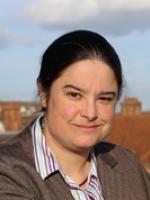
Professor of Mathematical Biology, DAMTP, University of Cambridge
David N. Moore Fellow in Mathematics, Queens' College
Current roles:
- Deputy Head of Department, DAMTP
- Vice President, Queens' College
- Director, Millennium Maths Project
- Co-lead, JUNIPER partnership
Honours and awards:
- 2023 IMA Hedy Lamarr Prize
- 2022 Weldon Memorial Prize (jointly by SPI-M-O)
- 2021 Royal Institution Christmas Co-Lecturer (with Jonathan Van Tam)
- 2020 OBE
- 2020 Honorary Membership of the Mathematical Association
- 2020 Royal Society Rosalind Franklin Award
- 2018 Vice-Chancellor's Impact Award
- 2018 Queens' teaching prize
- 2017 Whitehead Prize
- 2016 Forder Lecturer
- 2015 Pilkington Prize
- 2014 LMS popular lectures
Career:
- 2017-present Professor of Mathematical Biology
- 2013-2017 Reader in Mathematical Biology
- 2010-2012 Visiting Fellow, Ecology and Evolutionary Biology, Princeton University
- 2006-2013 University Lecturer, DAMTP, University of Cambridge
- 2006-2012 Royal Society University Research Fellowship, DAMTP, University of Cambridge
- 2004-present Official Fellow, Queens' College
- 2004-2006 Royal Society University Research Fellowship, Department of Zoology, University of Cambridge
- 2002-2004 Research Fellowship, Queens' College
Research:
Julia Gog's research is in the mathematics of infectious diseases. Recent projects include:
- Models of influenza strain dynamics
- Spatial spread of influenza
- Within-host dynamics of influenza
- In vitro dynamics of Salmonella
- Bioinformatic methods to detect RNA signals in viruses
University news items on our work
For list of publications, please try Julia's profile on Google Scholar.
Publications
Engagement and adherence trade-offs for SARS-CoV-2 contact tracing
– Philos Trans R Soc Lond B Biol Sci
(2021)
376,
20200270
(doi: 10.1098/rstb.2020.0270)
Epidemic interventions: Insights from classic results
– Philosophical Transactions of the Royal Society B: Biological Sciences
(2021)
376,
20200263
(doi: 10.1098/rstb.2020.0263)
SARS-CoV-2 incidence and vaccine escape
– The Lancet. Infectious diseases
(2021)
21,
913
Coughs, Colds and “Freshers’ Flu” Survey in the University of Cambridge, 2007-2008
(2021)
2021.03.31.21251220
(doi: 10.1101/2021.03.31.21251220)
Vaccine escape in a heterogeneous population: insights for SARS-CoV-2 from a simple model
(2021)
2021.03.14.21253544
(doi: 10.1101/2021.03.14.21253544)
Human mobility data from the BBC Pandemic project
(2021)
2021.02.19.21252079
(doi: 10.1101/2021.02.19.21252079)
Engagement and adherence trade-offs for SARS-CoV-2 contact tracing
(2020)
2020.08.20.20178558
(doi: 10.1101/2020.08.20.20178558)
Key questions for modelling COVID-19 exit strategies
– Proceedings. Biological sciences
(2020)
287,
20201405
(doi: 10.1098/rspb.2020.1405)
Effectiveness of isolation, testing, contact tracing, and physical distancing on reducing transmission of SARS-CoV-2 in different settings: a mathematical modelling study.
– Lancet Infectious Diseases
(2020)
20,
1151
Effectiveness of isolation, testing, contact tracing and physical distancing on reducing transmission of SARS-CoV-2 in different settings
(2020)
2020.04.23.20077024
(doi: 10.1101/2020.04.23.20077024)
- <
- 2 of 9
